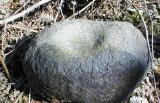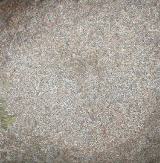Depression Stone
Among all objects presented on this website this one resisted best all efforts to identify or to date it. It was found on the surface by a private searcher many years ago. From my point of view this is the most mysterious and intriguing object presented on this website. It is a stone, some 50 kg of weight and 38 cm across, probably from granite.
Find state
Sketch
The stone features three regular depressions with diameters of 10-12 cm. Two depressions, named M1 and M2 on the sketch below, are some 2 to 2.5 cm deep and placed on opposing surfaces. A third depression M3 is just some 6 mm deep and perpendicular to the other depressions.
The dashed line indicates a hidden edge as common in technical drawings. In archaeology section drawings are more common.
Detail View 1
Detail View 2
Detail View 3
Detail view 3 shows the stone structure.
Identification Theories
I read many books to find clues as to why somebody would go through the tedious labour to create several depressions in such a hard stone. To date, there is no definite answer. In the books hundreds of arrow heads etc. are pictured but very few depression stones. Similar, in the museum thousands of small artifacts are on display but no such stones. All I can present are several theories.
Neolithical fashion
In neolithical times, which ended at 2000 BC, it was apparently fashionable to create depressions in stone surfaces. These depressions served no known practical purposes. In literature I found a picture showing depressions on a broken axe.
Similar observation can be made at the so called bullaun stones to be found in Ireland. These depressions have cylindrical rather than spherical shape, though.
Door bearing stone
In bronze age and iron age settlements in the Near East stones with depressions were used to serve as a bearing for a door. The following sketch shows the principle form.
Such stones are described in literature, e.g. in “Excavations in Tepe Guran in Luristan – the bronze age and iron age periods” by Henrik Thrane, Plate 25 and 34.
Since door bearing stones have usually just one depression I do not consider this theory very promising.
Bearing for pottery wheel
This sketch shows the principle.
According to literature, such bearing stones, made from granite, were found in iron age (800 BC to 0) settlements in northern Germany. Source: Archaeologie in Deutschland, 2/90, page 32.
Again, this theory does not explain why the stone had three depressions none of which are worn out.
Quern stone
A quern stone or grinding stone – a common suggestion - is not possible since quern stones always have even work panes.
Mortar
Some years ago, the leading stone age expert named Khamsin of the leading German find forum Heimdall (now closed) suggested the use as a mortar. I think this is the most probable theory to date.
Mortar stones principle shape.
Mortar stones, also doubled sided ones, where used from neolithical to medieval times, giving a vast time frame of 4000 BC to 1500 AD. When a depression was too deep or worn out the stone was turned. Over time a new depression was created. So the depression was partly desired, partly a by product.
In “The early history of metallurgy in Europe”, page 58, Tylecote mentions the special case of mortar stones used to smash iron ore pieces. He writes “But in the medieval period, the mortar stones where still used but with stone- or metal-ended wooden poles actuated by cams and water wheels.”
It does not show in the pictures above but all three depressions show a slight red-brown color. This indicates iron oxide. This in turn indicates that either iron hammers or pestles were used and/or iron ore was smashed using this mortar. Both cases narrow the time frame to at least 800 BC to 1500 AD.
(C) Thorsten Straub www.metal-detecting.de 2006-2019.







